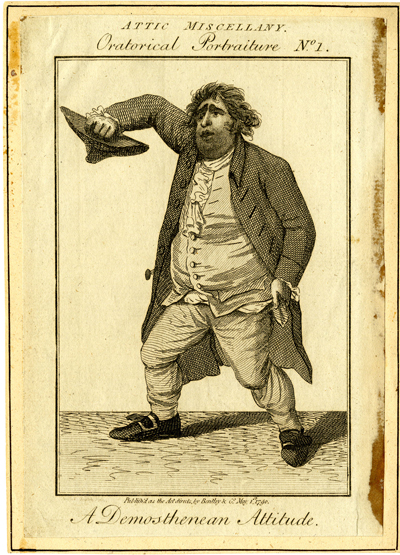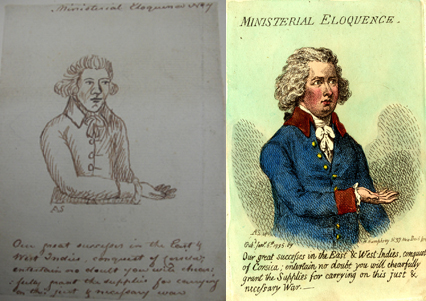Eloquence Series Overview
On January 6th 1795 Hannah Humphrey issued eight prints devoted to different kinds of eloquence.
- Bar Eloquence
- Billingsgate Eloquence
- Fools Eloquence
- Military Eloquence
- Ministerial Eloquence
- Naval Eloquence
- Opposition Eloquence
- Pulpit Eloquence

© Lewis Walpole Library, Yale University
Gillray had published paired prints on the same day, such as Innocence and Remorse (May 13, 1783), Absence and Remembrance (August 1, 1784), At Church and At the Opera (October 4, 1791), and, most recently, A Paris Belle and A Paris Beau (February 26, 1794). But this was the first time he had produced an extended series, thematically linked, all published on the same day.
Each of the prints in this new series featured a single figure caricature of an individual whose identity, appearance, and expression were intended to represent a branch of eloquence. The prints were sold separately. But since the portraits were card-sized (approximately 3 x 5 inches), they could also be combined and offered as a single 12 x 10 inch 8-panel unit (shown above).
Some of the figures can be easily identified with real-life models. Ministerial Eloquence, for instance, is clearly represented by Prime Minister William Pitt. Opposition Eloquence is just as clearly represented by the leader of the opposition, Charles James Fox. But others apppear to be more generic. Both the image and the sample of Pulpit Eloquence are so typical of long-standing images of overfed and boring prelates that there is neither need nor clear justification for associating the figure with a specific individual. Billingsgate eloquence was a well-understood phrase for the kind of vulgar and abusive language used by the fishwives of Billingsgate. And though there is some general resemblance to Lady Cecilia Johnston in Gillray's version of the fishwife, the words that come out of her mouth (mostly describing herself) are unimaginable as quotations from her ladyship.
The project may have been prompted by the re-issue of The Principles of Eloquence: Adapted to the Pulpit and the Bar by Abbe Maury and advertised in the Morning Post And Fashionable World for November 6th, 1794 just two months before the appearance of the Eloquence series. But since the signature lines on all but Naval Eloquence (clearly by Gillray himself) indicate "AS inv." the series is likely to have been suggested by Samuel Collings (who sometimes used the alias Annibal Scratch - AS) and who was responsible for several series of prints that had appeared in the Attic Miscellany (under the headings of "Oratorical Portraiture," "Legal Portraiture," and "Theatrical Portraiture.")

Oratorical Portraiture No. 1
[May 1, 1790]
© Trustees of the British Museum
After the Attic Miscellany folded in 1792, Collings may have sought to get some further mileage from the same basic idea with a series that would allow figures from the pulpit, the bar, and other forms of "eloquence" to be included.
For most of his career, Collings's relied upon other artists to do the etching or engraving of his ideas. At various times, he worked with Thomas Rowlandson, William Blake, Francis Jukes, John Barlow, and Walter Thomas. So it is not surprising that he might reach out to Gillray who was at the top of his game in 1795 to etch this new series. In this case, however, most of the original drawings for the series have been preserved in the British Museum, so we can see what Gillray received and what he did with it. We can see, for instance, that like the Attic Miscellany prints, the titles of the original drawings of the Eloquence series included a number. The fact that the first two in the series were Pulpit and Bar may further suggest the connection with the Abbe Maury publication.
- Pulpit Eloquence No. 1
- Bar Eloquence (Missing from the British Museum) No. 2
- Military Eloquence No. 3
- Fools Eloquence No. 4
- Billingsgate Eloquence No. 5
- Opposition Eloquence No. 6
- Ministerial Eloquence No. 7
But as in the Attic Miscellany, there is no sense of a sequence, a story to be told. They are simply members of a group devoted to Eloquence. So Gillray chose to ignore the numbering, instead (in the combined print) imposing his own grouping and color scheme that organizes the prints much more effectively. The two politicians are grouped by color and face one another. The two military men, both sons of King George, also share a color scheme and face one another. So too the Fool and Fish wife, leaving only the cleric and lawyer seeming slightly less organized.
Comparing the drawings (now in the British Museum) with the finished products, however, we can see that this is not the only improvement Gillray made. In fact, he has kept only the text and the most basic orientation and gestures from the original sketches, substantially redrawing every line of the original, and adding immensely to the sublety and finish of the whole.

© Trustees of the British Museum
In most cases when Gillray etched the work of others, even including amateurs like David Hess (Hollandia Regenerata) and Thomas Braddyll (A Military Sketch of a Gilt Stick, or Poker Emblazoned), he stayed remarkably true to the sketches he received. Yes, there were always subtle improvements that made the print better, but never wholesale recasting such as we see here. This was clearly an exception. Why?
We know very little about Samuel Collings, neither when he was born nor when he died. He was at his most prolific between 1784 and 1786 when he and Rowlandson collaborated on Boswell's Tour to the Hebrides. He was never the best draughtsman but at this best he had a crude energy that was appealing and not unike Rowlandson himself. He had another burst of activity between 1789 and 1793 when he worked for several magazines like the Attic Miscellany. But after that he seems to have disappeared. Some people assume that he must have died around that time because his output dropped to almost nothing but reprints of earlier caricatures. Like George Morland, John Hamilton Mortimer, and other caricaturists at the time, however, he was reputed to be a heavy drinker, and that may explain his virtual disappearance and some of the oddities of the Eloquence series and Gillray's handling of it.
We have already seen a similarity in the subject and approach between Collings' last identifiable work and the Eloquence series. But there is also a similarity in the handwriting on a 1785 drawing by Collings in the Victoria and Albert Museum for Boswell's Tour to the Hebrides and the handwriting on the Eloquence drawings by AS.

© Victoria & Albert Museum, London

Collings 1785
AS 1795
© Victoria & Albert Museum, London
Trustees of the British Museum
If this is, as I suspect, a last-ditch effort by an impoverished and ill Collings to make some money, that would help explain why the source is so poor in so many ways, and why Gillray was willing to go to such extraordinary lengths to make the series professional and attractive, even adding an extra eighth print devoted to Naval Eloquence so that a composite could be offered as, in effect, a ninth saleable print. Gillray must have already known and seen how hand to mouth a caricaturist's life could be, and he would later experience for himself how quickly fate can turn leaving one relying on the kindness of others. So in spite of the fact that he redrew every figure, etched every plate, and arranged the sequence and color for every print, he takes virtually no credit for any part of the production (except naval eloquence where he again understates his work), leaving "AS inv." as the primary indication of authorship.
* Photos of the drawings were taken by me with my phone. Alas, they are of poor quality, and I will happily replace them as soon as the British Museum digitizes the drawings themselves. But in the meantime, they provide a record of Gillray's source that no purely verbal description can match.
Sources and Reading
- "Samuel Collings," Wikipedia
- Julie Melby, "The Journey of Dr. Johnson and James Boswell to Scotland,"
- Collings at the V&A
Comments & Corrections
NOTE: Comments and/or corrections are always appreciated. To make that easier, I have included a form below that you can use. I promise never to share any of the info provided without your express permission.